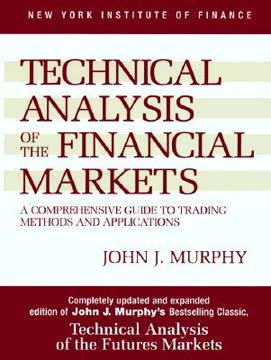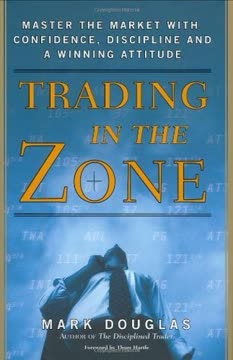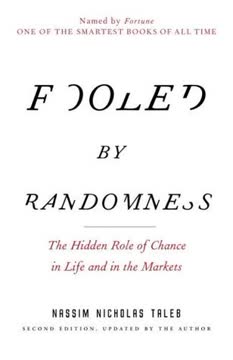मुख्य निष्कर्ष
1. बाजार आपूर्ति और मांग के कारण चलते हैं, व्यक्तिगत राय से नहीं
बाजार अपनी मर्जी से नहीं चलते, बल्कि उन्हें चलना पड़ता है।
बाजार आपूर्ति और मांग से संचालित होते हैं। जब मांग आपूर्ति से अधिक होती है तो कीमतें बढ़ती हैं, और जब आपूर्ति मांग से अधिक होती है तो कीमतें गिरती हैं। यह मूलभूत सिद्धांत आर्थिक संकेतकों, समाचारों या व्यक्तिगत राय से प्रभावित नहीं होता। ट्रेडर्स को अपने विश्वासों के बजाय वास्तविक बाजार व्यवहार पर ध्यान केंद्रित करना चाहिए कि कीमतें "कहाँ जानी चाहिए"।
भावनात्मक प्रतिक्रियाएं बड़े उतार-चढ़ाव को जन्म देती हैं। जब पर्याप्त संख्या में ट्रेडर्स गलत पक्ष पर फंस जाते हैं, तो बाजार में अचानक भय, निराशा और घबराहट के कारण तेजी से खरीद या बिक्री होती है। पेशेवर ट्रेडर्स इन भावनात्मक प्रतिक्रियाओं का फायदा उठाकर विपरीत दिशा में पोजीशन लेते हैं।
आपूर्ति/मांग असंतुलन के मुख्य कारण:
- मार्जिन कॉल के कारण मजबूरन पोजीशन बंद करना
- स्टॉप ऑर्डर का ट्रिगर होना
- मानसिक हार मान लेना
2. सफल ट्रेडिंग के लिए अनुशासन और पेशेवर मानसिकता आवश्यक है
भावनाएं शादी और अंतिम संस्कार के लिए ठीक हैं।
अपनी भावनाओं को नियंत्रित करें। सफल ट्रेडर्स अपने ट्रेडिंग प्लान का पालन बिना भय, लालच या अन्य भावनाओं के प्रभावित हुए करते हैं। इसके लिए अनुशासन और पेशेवर मानसिकता विकसित करनी होती है, जो व्यक्तिगत ट्रेड के परिणामों से अधिक लगातार निष्पादन पर केंद्रित होती है।
सामान्य मानसिक गलतियों से बचें। कई ट्रेडर्स अपनी ही आदतों जैसे अधिक ट्रेडिंग करना, बाजार का पीछा करना या घाटे में पोजीशन को लंबे समय तक रखना से खुद को नुकसान पहुंचाते हैं। इन प्रवृत्तियों को पहचानना और उन्हें दूर करना दीर्घकालिक सफलता के लिए जरूरी है।
मुख्य मानसिक चुनौतियां:
- अवसर चूकने का डर (FOMO)
- छोटे नुकसान स्वीकार न कर पाना
- जीत की लकीर के बाद अति आत्मविश्वास
- विश्लेषण में उलझना
3. अपने ट्रेडिंग तकनीक को बेहतर प्रदर्शन के लिए तैयार करें
यदि ट्रेडर्स इस हिस्से को सही कर लें, तो वे सभी के साथ बराबरी की लड़ाई लड़ सकते हैं।
विश्वसनीय हार्डवेयर और सॉफ्टवेयर में निवेश करें। ट्रेडर का कंप्यूटर और निष्पादन प्लेटफॉर्म अत्यंत महत्वपूर्ण उपकरण हैं। उच्च प्रदर्शन वाला सिस्टम लें जिसमें पर्याप्त RAM, कई मॉनिटर और मजबूत बैकअप समाधान हो ताकि महंगे डाउनटाइम या त्रुटियों से बचा जा सके।
अपनी तकनीक का रख-रखाव और सुरक्षा करें। नियमित रूप से सॉफ्टवेयर अपडेट करें, स्पायवेयर हटाएं, हार्ड ड्राइव डिफ्रैगमेंट करें और साइबर सुरक्षा के सर्वोत्तम उपाय अपनाएं। यह निवारक रखरखाव महत्वपूर्ण ट्रेडिंग समय के दौरान सुचारू संचालन सुनिश्चित करता है।
आवश्यक तकनीकी घटक:
- उच्च RAM वाला कंप्यूटर (कम से कम 1GB)
- कई मॉनिटर
- अनइंटरप्टिबल पावर सप्लाई (UPS)
- विश्वसनीय इंटरनेट कनेक्शन और बैकअप
- पेशेवर ग्रेड चार्टिंग और निष्पादन सॉफ्टवेयर
4. इंट्राडे दिशा का आकलन करने के लिए बाजार के आंतरिक संकेत समझें
संगीतकार संगीत पढ़ना जानते हैं; ट्रेडर्स को बाजार पढ़ना आना चाहिए।
प्रमुख बाजार संकेतकों पर नजर रखें। सफल इंट्राडे ट्रेडर्स TICK, TRIN और Put/Call अनुपात जैसे विभिन्न बाजार आंतरिक संकेतकों को समझने में दक्ष होते हैं। ये संकेतक मूल्य चाल को प्रभावित करने वाले खरीद और बिक्री दबाव की जानकारी देते हैं।
ट्रेड सेटअप की पुष्टि के लिए आंतरिक संकेतों का उपयोग करें। केवल मूल्य चाल या तकनीकी संकेतकों पर निर्भर रहने के बजाय, संभावित ट्रेडों की पुष्टि और समग्र बाजार भावना का आकलन करने के लिए बाजार के आंतरिक संकेतों को शामिल करें। यह बहुआयामी दृष्टिकोण सफल ट्रेडों की संभावना बढ़ाता है।
महत्वपूर्ण बाजार आंतरिक संकेत:
- NYSE TICK
- TRIN (आर्म्स इंडेक्स)
- Put/Call अनुपात
- एडवांस/डिक्लाइन लाइन
- सेक्टर प्रदर्शन
5. उच्च संभावना वाले ट्रेड पहचानने के लिए विशिष्ट सेटअप का उपयोग करें
बिना किसी विशिष्ट सेटअप के ट्रेडिंग करना अमेज़न में बिना कम्पास के ट्रेकिंग करने जैसा है।
प्रमाणित सेटअप का संग्रह विकसित करें। सफल ट्रेडर्स अपनी व्यक्तिगतता और जोखिम सहिष्णुता के अनुरूप कुछ उच्च संभावना वाले ट्रेड सेटअप पर ध्यान केंद्रित करते हैं। ये सेटअप विभिन्न बाजार स्थितियों में संभावित ट्रेडों की पहचान के लिए एक व्यवस्थित तरीका प्रदान करते हैं।
सेटअप को निरंतर परिष्कृत और अनुकूलित करें। अपने ट्रेड सेटअप के प्रदर्शन की नियमित समीक्षा करें और बाजार की परिस्थितियों के अनुसार समायोजन करें। जो सेटअप काम करना बंद कर दें उन्हें त्यागने और नए अवसरों की खोज करने के लिए तैयार रहें।
पुस्तक में वर्णित उदाहरण ट्रेड सेटअप:
- ओपनिंग गैप प्ले
- पिवट पॉइंट ट्रेड
- स्क्वीज सेटअप
- ब्रिक प्ले
- HOLP और LOHP रिवर्सल
6. जोखिम प्रबंधन और पोजीशन साइजिंग रणनीतियाँ लागू करें
पेशेवर ट्रेडर्स जोखिम सीमित करने और पूंजी की सुरक्षा पर ध्यान देते हैं। शौकिया ट्रेडर्स हर ट्रेड पर कितना पैसा कमाएंगे, इस पर ध्यान देते हैं।
हर ट्रेड के लिए जोखिम मानदंड निर्धारित करें। पोजीशन लेने से पहले अपनी अधिकतम स्वीकार्य हानि तय करें और उसके अनुसार स्टॉप-लॉस ऑर्डर लगाएं। यह पूर्वनिर्धारित जोखिम भावनात्मक निर्णयों को रोकने में मदद करता है।
पोजीशन का उचित आकार निर्धारित करें। अपने कुल खाते की पूंजी के सापेक्ष पोजीशन साइज को सीमित रखें ताकि ओवरलेवरेजिंग से बचा जा सके। सामान्य नियम है कि किसी भी एक ट्रेड में खाते का 1-2% से अधिक जोखिम न लें।
मुख्य जोखिम प्रबंधन सिद्धांत:
- स्टॉप-लॉस ऑर्डर का नियमित उपयोग
- घाटे में पोजीशन में अतिरिक्त निवेश से बचाव
- जीतने वाले ट्रेड से आंशिक लाभ लेना
- उचित पोजीशन साइजिंग लागू करना
7. एक व्यापक ट्रेडिंग योजना बनाएं और उसका पालन करें
जो ट्रेडर्स इस व्यवसाय में प्रतिस्पर्धात्मक बढ़त बनाए रखना चाहते हैं, उन्हें पहले आज की तकनीकी खतरों से अवगत होना चाहिए।
विस्तृत व्यापार योजना बनाएं। अपने ट्रेडिंग लक्ष्य, रणनीतियाँ, जोखिम प्रबंधन नियम और प्रदर्शन मापदंडों को स्पष्ट रूप से लिखें। एक सुव्यवस्थित योजना लगातार निर्णय लेने के लिए ढांचा प्रदान करती है और चुनौतीपूर्ण बाजार स्थितियों में अनुशासन बनाए रखने में मदद करती है।
अपनी योजना की नियमित समीक्षा और अद्यतन करें। साप्ताहिक, मासिक और त्रैमासिक आधार पर अपने ट्रेडिंग प्रदर्शन का मूल्यांकन करें। सुधार के क्षेत्रों की पहचान करें और योजना में आवश्यक बदलाव करें। बाजार की बदलती परिस्थितियों के अनुसार अनुकूलित होने के लिए तैयार रहें, लेकिन अपने मूल सिद्धांतों को बनाए रखें।
ट्रेडिंग योजना के आवश्यक तत्व:
- ट्रेडिंग लक्ष्य और उद्देश्य
- विशिष्ट रणनीतियाँ और सेटअप
- जोखिम प्रबंधन नियम
- पोजीशन साइजिंग दिशानिर्देश
- प्रदर्शन ट्रैकिंग और समीक्षा प्रक्रिया
- निरंतर शिक्षा और सुधार योजना
अंतिम अपडेट:
FAQ
What's Mastering the Trade about?
- Trading Psychology: The book emphasizes the psychological aspects of trading, focusing on how emotions can lead to poor decision-making and the importance of understanding one's mental state.
- Practical Techniques: John F. Carter provides proven techniques for intraday and swing trading setups, covering strategies with specific entry and exit points to maximize profits.
- Market Mechanics: It explains the basic mechanics of different markets, including stocks, futures, and forex, which is crucial for traders to navigate and profit from these markets.
Why should I read Mastering the Trade?
- Comprehensive Guide: The book serves as a comprehensive guide for traders at all levels, offering insights into trading psychology, market mechanics, and specific strategies.
- Real-World Examples: Carter uses real-world examples and case studies to illustrate concepts, making them relatable and easier to understand.
- Risk Management Focus: Emphasizes the importance of risk management and developing a trading plan, providing actionable advice on protecting capital and managing trades effectively.
What are the key takeaways of Mastering the Trade?
- Market Movements: Understanding that market movements are driven by human emotions and reactions, which traders must comprehend to succeed.
- Psychological Phases: Carter outlines three phases traders typically go through, helping them identify their current mindset and adjust strategies accordingly.
- Importance of Setup: Stresses the significance of having a specific trading setup and sticking to it, advising against impulsive decisions based on emotions.
What are the best quotes from Mastering the Trade and what do they mean?
- "Amateurs hope; professionals steal.": Highlights the difference between amateur and professional traders, emphasizing calculated actions over reliance on luck.
- "It's not the economy, stupid.": Suggests that market movements are driven by trader psychology rather than economic indicators, encouraging focus on market sentiment.
- "The financial markets are naturally set up to take advantage of and prey upon human nature.": Emphasizes the importance of understanding human psychology in trading.
How does Mastering the Trade address trading psychology?
- Emotional Awareness: Carter stresses that emotions can be detrimental in trading, encouraging traders to develop self-awareness and recognize their emotional impact.
- Professional Mindset: Suggests adopting a professional mindset, focusing on setups rather than outcomes, to manage emotions and make rational decisions.
- Trader Development Phases: Outlines psychological phases traders go through, aiding in personal development and improving trading performance.
What specific trading strategies are discussed in Mastering the Trade?
- Gap Trading: Discusses the "Opening Gap" strategy, providing rules for identifying high-probability gap trades and managing them effectively.
- Pivot Points: Covers using pivot points for both trending and choppy market conditions, explaining setup on charts and trading psychology.
- Scalping Techniques: Introduces scalping strategies for quick trades, emphasizing timing and execution in fast-paced trades.
What is the TRIN and how is it used in trading according to Mastering the Trade?
- TRIN Definition: The TRIN, or Arms Index, is a market breadth indicator measuring the relationship between advancing and declining stocks and their volume.
- Interpreting TRIN Values: A TRIN value above 2.0 indicates a high likelihood of a market rally, while a value below 0.60 suggests a potential sell-off.
- Practical Application: Traders can use TRIN readings to focus on long or short setups based on previous day’s values, aiding in trading decisions.
How does the put/call ratio work in trading as explained in Mastering the Trade?
- Understanding the Ratio: Compares the volume of put options to call options, providing insight into market sentiment.
- Key Thresholds: A put/call ratio above 1.0 signals extreme bearishness, while a ratio below 0.60 indicates extreme bullishness.
- Market Dynamics: Helps traders understand market participant positioning, allowing anticipation of potential reversals.
What are pivot points and how are they used in Mastering the Trade?
- Pivot Points Definition: Technical indicators used to identify potential support and resistance levels based on the previous day’s high, low, and close.
- Calculating Pivot Points: Involves using a simple formula that averages the previous day’s price action to determine key levels.
- Trading Strategy: Used to set entry and exit points, with traders looking for bounces or reversals at pivot points.
How can I apply the concepts from Mastering the Trade to my trading?
- Develop a Trading Plan: Carter stresses having a well-defined plan with specific setups, risk management strategies, and performance tracking.
- Practice Discipline: Encourages sticking to setups and avoiding impulsive decisions based on emotions, crucial for long-term success.
- Utilize Market Internals: Discusses using market internals like ticks and TRIN to gauge market direction, improving decision-making.
How does Mastering the Trade suggest managing risk?
- Set Stop Losses: Emphasizes using stop-loss orders to limit potential losses, with guidelines for determining appropriate levels.
- Position Sizing: Discusses the significance of proper position sizing to manage risk effectively, advising specific capital allocation per trade.
- Drawdown Rules: Recommends establishing daily and monthly drawdown rules to protect capital, suggesting cutting positions or halting trading if thresholds are exceeded.
What are the common mistakes traders make according to Mastering the Trade?
- Lack of a Plan: Entering the market without a clear trading plan leads to impulsive decisions and losses.
- Emotional Trading: Letting emotions dictate actions results in poor decision-making; maintaining control is advised.
- Overtrading: Warns against overtrading, especially in choppy markets, encouraging patience for high-probability setups.
समीक्षाएं
मास्टरिंग द ट्रेड को मिली-जुली प्रतिक्रियाएँ मिली हैं। कुछ पाठक इसकी ट्रेडिंग मनोविज्ञान और रणनीतियों, खासकर TTM स्क्वीज़ सेटअप की समझ की प्रशंसा करते हैं। वहीं, कुछ लोग इस किताब की आलोचना करते हैं कि इसमें भुगतान किए गए संकेतकों और विशिष्ट सेटअप्स को बिना उचित व्याख्या के बढ़ावा दिया गया है। कई पाठकों का मानना है कि यह सामग्री स्विंग ट्रेडिंग की तुलना में डे ट्रेडिंग के लिए अधिक उपयुक्त है। कुछ समीक्षक लेखक के स्पष्ट और मनोरंजक अंदाज की सराहना करते हैं, जबकि अन्य इसे केवल एक बिक्री प्रस्तुति के रूप में देखते हैं। इस किताब का मूल्य पाठक के अनुभव स्तर और अपेक्षाओं पर निर्भर करता प्रतीत होता है, जिसमें शुरुआती ट्रेडर्स इसे अधिक उपयोगी पाते हैं जबकि अनुभवी ट्रेडर्स के लिए यह कम कारगर हो सकती है।
Similar Books














